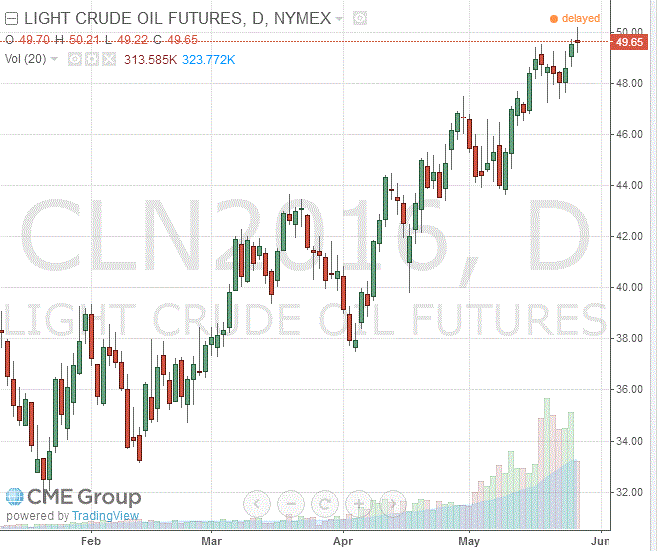Noticias del mercado
-
17:42
Oil quotes show negative dynamics
Oil prices rose above $ 50 a barrel for the first time in nearly seven months, but then again returned to negative territory on the background growth of the US dollar.
In recent weeks, crude oil rose in price against the background of supply disruptions, mainly due to the decrease in supply of raw materials from Canada due to raging forest fires and Nigeria because of the unrest. Reduction of oil reserves in the US also increased the hopes of beginning to restore the balance in the market. Yesterday the US Department of Energy reported that in the week ended May 20, commercial crude oil inventories fell by 4.2 million barrels, while analysts had expected a decline of 2.5 million barrels. However, gasoline stocks last week rose unexpectedly, as demand declined. After Memorial Day in the US should begin the season of active road trips, and a relatively low consumption can put pressure on prices. Gasoline inventories in the US rose by 2.043 million barrels to 240.111 million barrels. Distillate stocks fell by 1.284 million barrels to 150.878 million barrels. Workload refinery in the United States decreased to 89.7% from 90.5% a week earlier. Oil in the US last week fell the 11th week in a row, reaching 8.8 million barrels per day.
However, analysts note that many of the supply disruptions are temporary. Higher prices could also hinder the recovery in the long term, as they encourage US producers to increase production. Meanwhile, experts believe that when the levels of $ 51- $ 52 oil prices may fall again by about $ 6- $ 10. In this case, investors may be more prone to alignment positions or profit.
Important market participants also switched to the meeting of representatives of the OPEC countries, which is scheduled for June 2nd. Discussion will focus on the possibilities of raising prices and stabilize the market.
WTI for delivery in July fell to $49.65 a barrel. Brent for July fell to $49.50 a barrel.
-
17:21
The price of gold back to the opening level
Quotes of gold increased significantly at the beginning of the session, but then fell back to the opening level, which was caused by the strengthening of the dollar in response to the strong US data.
The US Commerce Department reported that orders for long-term industrial goods increased in April against the background of the high demand for transport equipment and a number of other products, but the continuing weakness of the planned business spending suggests that the decline in production is far from complete. According to the data, orders for durable goods jumped 3.4 percent last month after a revised upward growth of 1.9 percent in March. Earlier it was reported that orders for durable goods rose 1.3 percent in March. Non-defense capital goods orders excluding aircraft, which are closely monitored by the sensor of the planned business spending, fell 0.8 percent after an upwardly revised decline of 0.1 percent in the previous month. Earlier it was reported that they fell by 0.8 percent in March. Economists forecast that orders for durable goods rise by 0.5 percent last month and core capital goods orders to rise by 0.4 per cent.
The growth of long-term orders was another signal that the economy is gaining momentum after the growth slowed down to 0.5 per cent per annum in the 1st quarter. So far, reports on retail sales, industrial production and housing have offered a favorable opinion on the economy at the beginning of the second quarter.
In anticipation of its meeting the Fed is looking for signs that economic growth is accelerating, and the economic situation abroad has stabilized. More positive data may give some confidence the leadership of the Central Bank. Now investors are waiting for Fed Chairman Yellen speech, scheduled for Friday, which may to some extent make it clear whether the Central Bank will raise rates soon. Futures on interest rates Fed indicate that the probability of increase is 30% rate in June, and is estimated at 60% in July. Recall, higher interest rates have a downward pressure on the price of gold, which brings its holders to interest income and that is difficult to compete with the assets, bringing that income against the background of increasing interest rates.
"Gold has entered a phase of consolidation due to expectations that the Fed will raise rates this summer - said Carlo Alberto de Casa, chief analyst at ActivTrades -. Today, we have seen only a technical rebound after yesterday precious metal touched a high of $ 1217."
Gold rose more than 15 percent since the beginning of the year, as investors bought the metal amid concerns over global economic growth and stock market volatility. But physical demand from China and India, the major markets, which accounted for more than half of world consumption, was weak.
The cost of the June gold futures on the COMEX fell to $ 1222.4 per ounce.
-
00:30
Commodities. Daily history for May 25’2016:
(raw materials / closing price /% change)
Oil 49.74 +0.36%
Gold 1,224.30 +0.04%
-

